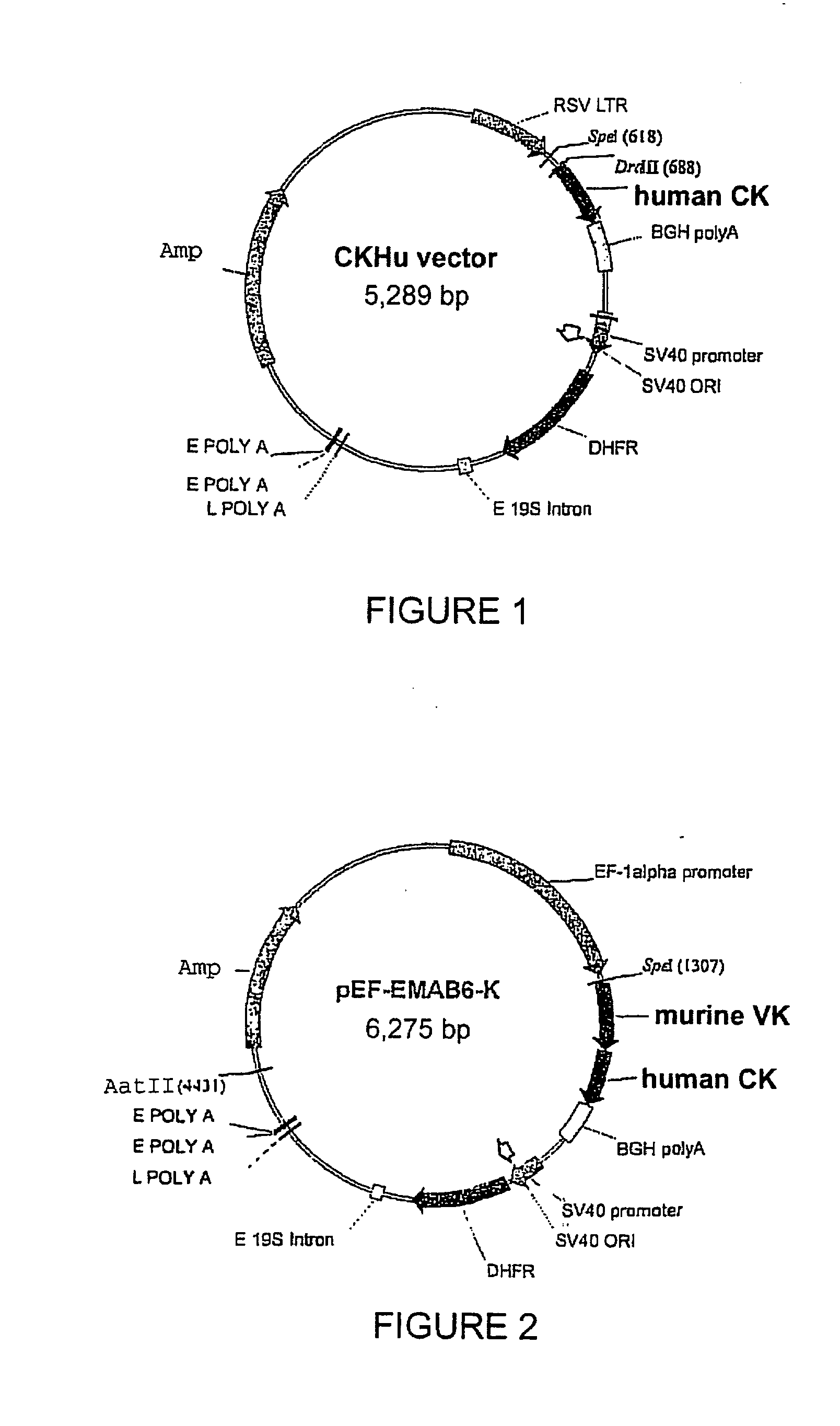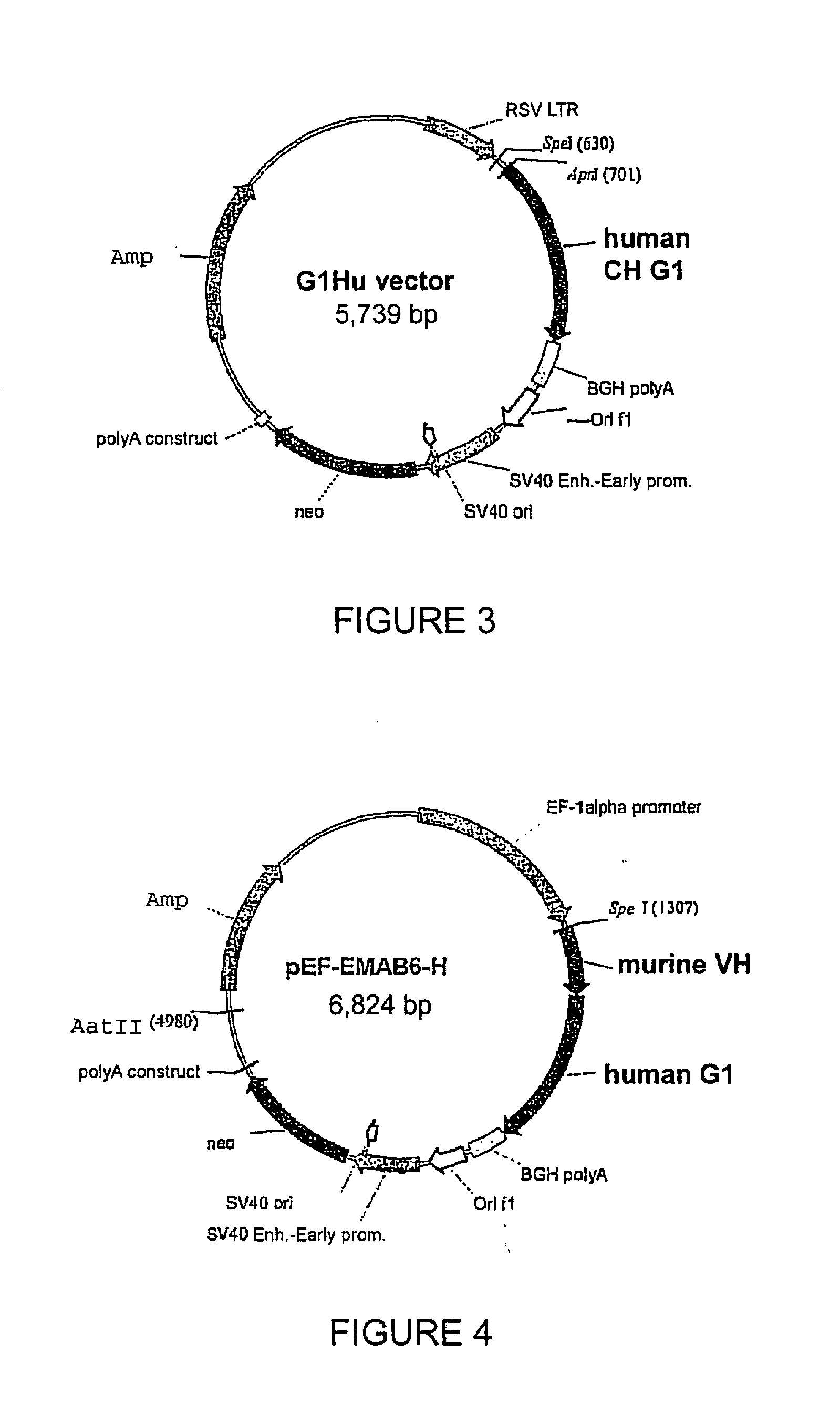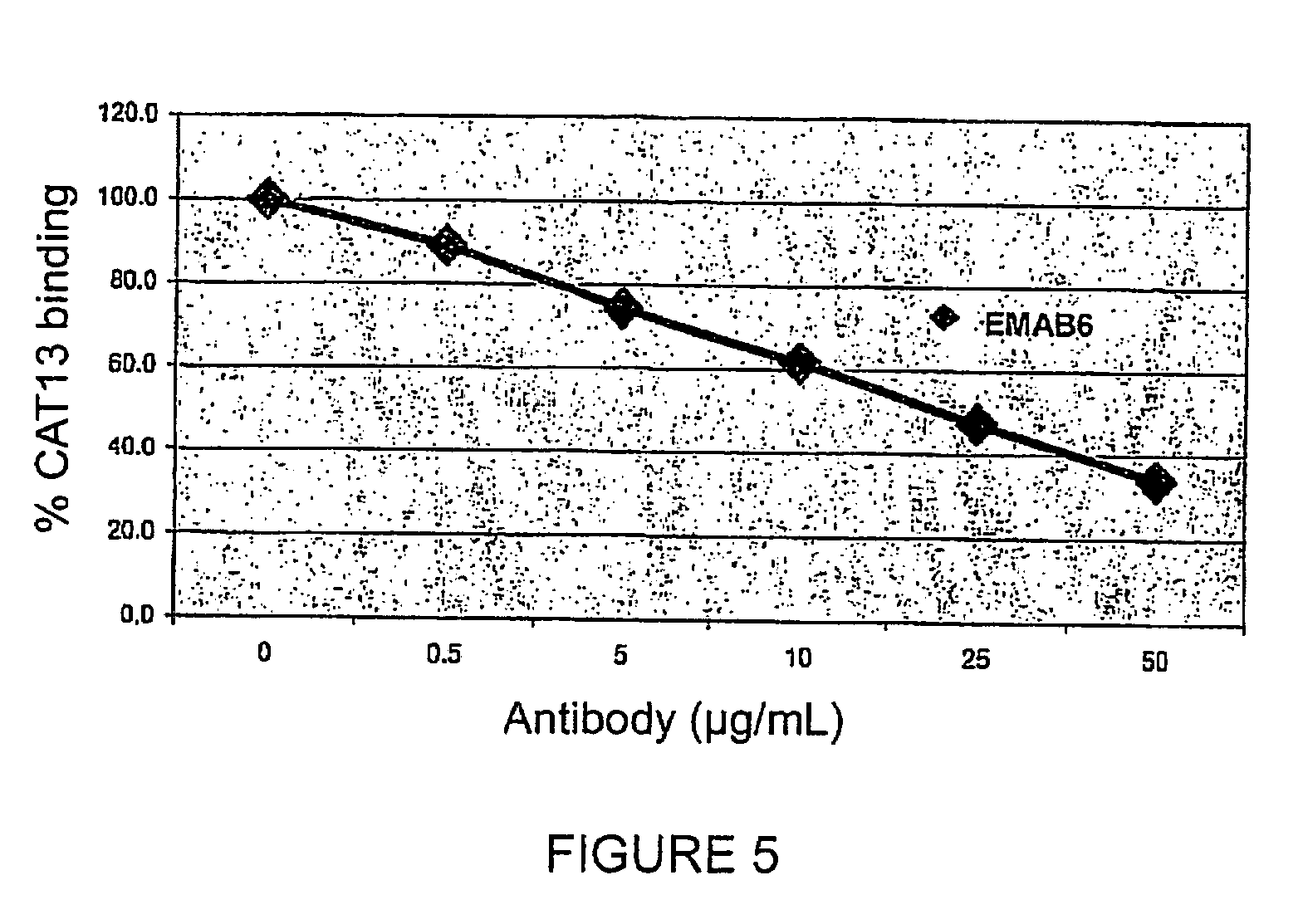Cytotoxic Antibody Directed Against Type B Lymphoid Hematopoietic Proliferations
a lymphoid hematopoietic and cytotoxic antibody technology, applied in the direction of fused cells, drug compositions, immunological disorders, etc., can solve the problems of rituxan® having only a modest effect on b cells in b-cll, complement activity is the cause of deleterious side effects, and the effectiveness of rituxan® remains variable and frequently modest. to achieve the effect of reducing the dose of patients
- Summary
- Abstract
- Description
- Claims
- Application Information
AI Technical Summary
Benefits of technology
Problems solved by technology
Method used
Image
Examples
example 1
Construction of Expression Vectors for Anti-CD20 Chimeric Antibodies EMAB6 and EMAB603
A. Determination of the Sequence of the Variable Regions Of the CAT-13.6E12 Murine Antibody
[0086]Total RNA from murine hybridoma CAT-13.6E12 cells (supplier: DSMZ, ref. ACC 474), which produces an IgG2a, κ-type immunoglobulin, was isolated (RNAeasy kit, Qiagen ref. 74104). After reverse transcription, the variable domains of the light (Vκ) and heavy (VH) chains of the CAT-13.6E12 antibody were amplified using the 5′RACE technique (Rapid Amplification of cDNA Ends) (GeneRacer kit, Invitrogen ref. L1500-01). The primers used for the two steps were the following:
1. Reverse Transcription Primers
[0087]a. Murine Kappa specific antisense primer (SEQ ID No. 1)
5′- ACT GCC ATC AAT CTT CCA CTT GAC -3′
b. Murine G2a specific antisense primer (SEQ ID No. 2)
5′- CTG AGG GTG TAG AGG TCA GAC TG -3′
2. 5′RACE PCR Primers
[0088]a. Murine Kappa specific antisense primer (SEQ ID No. 3)
5′- TTGTTCAAGAAGCACACGACTGAGGCAC -3′
b...
example 2
Production of Cell Lines Derived from the YB2 / 0 Line Producing Anti-CD20 Chimeric EMAB6 and EMAB603 Antibodies
[0110]The rat YB2 / 0 cell line (ATCC # CRL-1662) was cultivated in EMS medium (Invitrogen, ref. 041-95181M) containing 5% foetal calf serum (JRH Biosciences, ref. 12107). For transfection, 5 million cells were electroporated (Biorad electroporator, model 1652077) in Optimix medium (Equibio, ref. EKITE 1) with 25 μg of light chain vector pEF-EMAB6-K (FIG. 2), linearised with AatII, and 27 μg of heavy chain vector pEF-EMAB6-H (FIG. 4), linearised with ScaI, for the expression of the EMAB6 antibody, or with vector pRSV-HL-EMAB603, for the expression of the EMAB603 antibody. The electroporation conditions applied were 230 Volts and 960 microFarads in a 0.5-mL cuvette. Each electroporation cuvette was then distributed over 5 P96 plates at a density of 5,000 cells / well.
[0111]Placement in a selective RPMI medium (Invitrogen, ref 21875-034) containing 5% dialysed serum (Invitrogen, r...
example 3
Characterisation of the Functional Activity of Chimeric Antibodies EMAB6 and EMAB603
A. Specificity
[0116]Specificity of the antigen recognition of the chimeric EMAB6 antibody was evaluated by studying the competition with the murine antibody CAT-13.6E12 (CAT13) for binding the CD20 antigen expressed by Raji cells.
[0117]For that purpose, the EMAB6 antibody (10 μL at 0.5 to 50 μg / mL) was incubated at 4° C. with a fixed quantity of CAT-13.6E12 murine antibody (10 μL at 5 μg / mL) for 20 minutes in the presence of Raji cells (50 μL at 4×106 cells / mL). After washing, a mouse anti-IgG antibody coupled to phycoerythrin (PE) was added to the Raji cells so as to specifically detect the binding of the CAT-13.6E12 murine antibody. The Median Fluorescence Intensities (MFIs) obtained in the presence of various concentrations of EMAB6 are converted to percentages, with 100% corresponding to binding to CAT-13.6E12 cells in the absence of the EMAB6 antibody.
[0118]An inhibition curve is thus obtained f...
PUM
| Property | Measurement | Unit |
|---|---|---|
| molecular weight | aaaaa | aaaaa |
| concentrations | aaaaa | aaaaa |
| concentrations | aaaaa | aaaaa |
Abstract
Description
Claims
Application Information
 Login to View More
Login to View More - R&D
- Intellectual Property
- Life Sciences
- Materials
- Tech Scout
- Unparalleled Data Quality
- Higher Quality Content
- 60% Fewer Hallucinations
Browse by: Latest US Patents, China's latest patents, Technical Efficacy Thesaurus, Application Domain, Technology Topic, Popular Technical Reports.
© 2025 PatSnap. All rights reserved.Legal|Privacy policy|Modern Slavery Act Transparency Statement|Sitemap|About US| Contact US: help@patsnap.com



